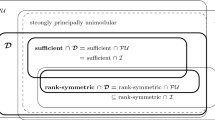Abstract
We present a theorem stating that certain classes of linear programming problems have integer optimal (primal and dual) solutions. The theorem includes as special cases earlier results of Johnson, Edmonds and Giles, Frank, Hoffman and Schwartz, Gröflin and Hoffman, and Lawler and Martel. The proof method consists of deriving total dual integrality for the corresponding system of linear inequalities from the total unimodularity of certain ‘cross-free’ subsystems. The scheme presented here differs from the one proposed earlier by Grishuhin in that Grishuhin requires the total unimodularity of cross-free subsystems in the axioms, whereas here this follows from easier verifiable axioms.
Similar content being viewed by others
References
W.H. Cunningham and A.B. Marsh III, “A primal algorithm for optimum matching”,Mathematical Programming Study 8 (1978) 50–72.
J. Edmonds, “Submodular functions, matroids and certain polyhedra”, in: R. Guy, et al. eds.Combinatorial structures and their applications (Gordon and Breach, New York, 1970), pp. 69–87.
J. Edmonds and R. Giles, “A min-max relation for submodular functions on graphs”,Annals of Discrete Mathematics 1 (1977) 185–204.
L.R. Ford and D.R. Fulkerson, “Maximum flow through a network”,Canadian Journal of Mathematics 8 (1956) 399–404.
A. Frank, “Kernel systems of directed graphs”,Acta Scientiarum Mathematicarum 41 (1979) 63–76.
A. Frank, “Generalized polymatroids”,Proceedings Sixth Hungarian Combinatorial Colloquium (Eger, 1981), to appear.
A. Frank, “An algorithm for submodular functions on graphs”,Annals of Discrete Mathematics 16 (1982) 97–120.
A. Frank, “Finding feasible vectors of Edmonds-Giles polyhedra”,Journal of Combinatorial Theory (B), to appear.
S. Fujishige, “Structures of polytopes determined by submodular functions on crossing families”, Report No. 121 (81-22), Institute of Socio-Economic Planning, University of Tsukuba, 1981.
S. Fujishige, “Algorithms for solving the independent flow problems”,Journal of the Operations Research Society of Japan 21 (1978) 189–203.
D.R. Fulkerson, “Packing rooted directed cuts in a weighted directed graph”,Mathematical Programming 6 (1974) 1–13.
R. Giles, “Optimum matching forests 1: Special weights”,Mathematical Programming 22 (1982) 1–11.
R. Giles, “Optimum matching forests II: General weights”,Mathematical Programming 22 (1982) 12–38.
R. Giles, “Optimum matching forests III: Facets of matching forest polyhedra”,Mathematical Programming 22 (1982) 39–51.
V.P. Grishuhin, “Polyhedra related to a lattice”,Mathematical Programming 21 (1981) 70–89.
H. Gröflin and A.J. Hoffman, “Lattice polyhedra II: Constructions and examples”, preprint.
M. Grötschel, L. Lovász and A. Schrijver, “The ellipsoid method and its consequences in combinatorial optimization”,Combinatorica 1 (1981) 169–197.
R. Hassin, “On network flows”, Ph.D. Dissertation. Yale University (New Haven, CT, 1978) (cf.Networks 12 (1982) 1–21).
A.J. Hoffman, “A generalization of max-flow min-cut”,Mathematical Programming 6 (1974) 352–359.
A.J. Hoffman and D. Schwartz, “On lattice polyhedra”, in: A. Hajnal and Vera T. Sós, eds.,Combinatorics (North-Holland, Amsterdam, 1978), pp. 593–598.
E.L. Johnson, “On cut-set integer polyhedra”,Cahiers du Centre d'Études de Recherche Opérationnelle 17 (1975) 235–251.
E.L. Lawler and C.U. Martel, “Computing maximal ‘polymatroidal’ network flows”,Mathematics of Operations Research 7 (1982) 334–347.
C.L. Lucchesi and D.H. Younger, “A minimax relation for directed graphs”,Journal of the London Mathematical Society (2) 17 (1978) 369–374.
A. Schrijver, “Min-max relations for directed graphs”,Annals of Discrete Mathematics 16 (1982) 127–146.
A. Schrijver, “Short proofs on the matching polyhedron”,Journal of Combinatorial Theory (B) 34 (1983) 104–108.
A. Schrijver, “Total dual integrality from directed graphs, crossing families, and sub- and supermodular functions”, in: J.A. Bondy, U.S.R. Murty and W.R. Pulleyblank, eds.,Proceedings of the Silver Jubilee Conference on Combinatorics Waterloo 1982, to appear.
A. Schrijver and P.D. Seymour, “A proof of total dual integrality of matching polyhedra”, Report ZN 79, Mathematical Centre, Amsterdam, 1977.
W.T. Tutte, “Lectures on matroids”,Journal of Research National Bureau of Standards 69B (1965) 1–47.
U. Zimmermann, “Minimization of some nonlinear functions over polymatroidal network flows”,Annals of Discrete Mathematics 16 (1982) 287–309.
Author information
Authors and Affiliations
Rights and permissions
About this article
Cite this article
Schrijver, A. Proving total dual integrality with cross-free families—A general framework. Mathematical Programming 29, 15–27 (1984). https://doi.org/10.1007/BF02591726
Received:
Revised:
Issue Date:
DOI: https://doi.org/10.1007/BF02591726




